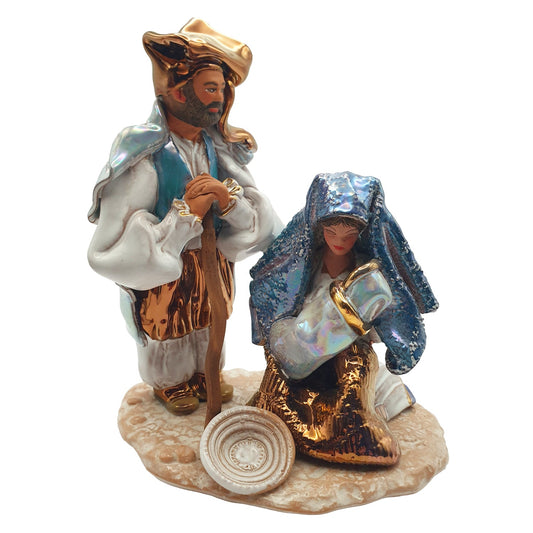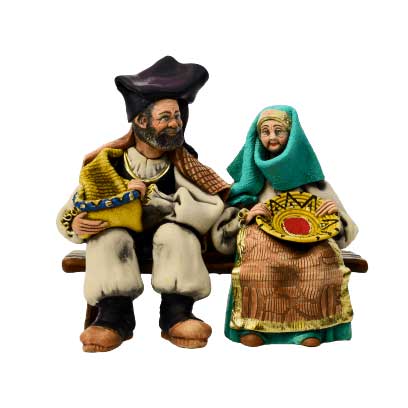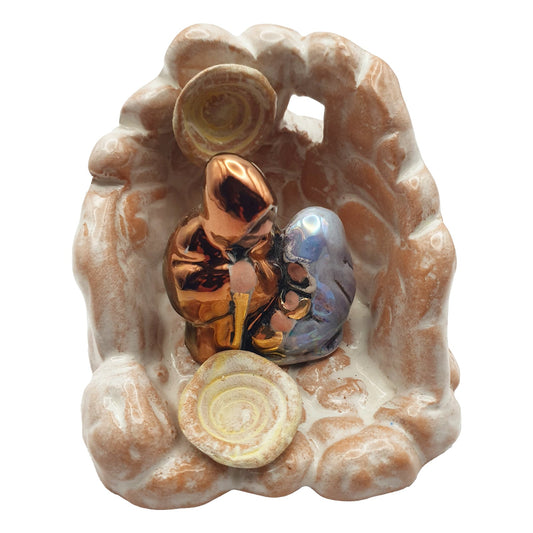Quando si avvicina il periodo del Natale, per gli appassionati è il momento di tirare fuori gli scatoloni con le decorazioni, l’albero e il presepio artigianale di famiglia. C’è chi aspetta il mese di novembre per iniziare a costruire il modellino; chi ci pensa tutto l’anno e lentamente produce i singoli pezzi; chi lo fa rigorosamente l’8 dicembre, né prima né dopo. Nel settore non mancano i collezionisti specializzati, che ogni anno arricchiscono il proprio scenario con nuove versioni della Natività. In questo articolo scopriremo qualcosa di più sulla storia del presepe, sulla sua invenzione e sulla tradizione artigianale di statuette in ceramica, realizzate in Italia e in Sardegna.
Presepio Artigianale
-
Chi è stato il primo a fare il presepe?
LA NATIVITÅ NEI PRIMI SECOLI DEL CRISTIANESIMO
A partire dal IV secolo, quando venne riconosciuta la libertà di culto della fede cristiana da parte dell’Imperatore Costantino, in tutto il territorio cristiano iniziarono le rappresentazioni della Natività, dove i protagonisti erano la Sacra Famiglia, il mulo, il bue, i tre Re Magi, la stella di Betlemme e i pastori, ai quali si aggiunsero altri episodi biblici nel tempo, come l'Annunciazione, la Visitazione, la Ricerca della locanda, la Strage degli Innocenti e la Fuga in Egitto. Gli artisti bizantini crearono
-

Handcrafted Nativity Scene
Choose your handcrafted nativity scene made in Sardinia.
-
Nativity scene with nuraghe, matte glaze, 13 cm
Regular price €69,00 EURRegular priceUnit price / per -
Sardinian ceramic nativity scene, matte glaze, 16 cm
Regular price €59,00 EURRegular priceUnit price / per -
Sardinian ceramic nativity scene, glossy, 16 cm
Regular price €62,00 EURRegular priceUnit price / per -
Couple of Elders on a Bench, 18 cm
Regular price €86,00 EURRegular priceUnit price / per -
Busto Uomo Costume Sardo con Bisaccia, 16 cm
Regular price €40,00 EURRegular priceUnit price / per -
Ceramic Madonna, glossy enamel. 25 cm
Regular price €70,00 EURRegular priceUnit price / per -
Nativity in Sardinian ceramic, glossy glaze, 20 cm
Regular price €120,00 EURRegular priceUnit price / per -
Sardinian ceramic nativity scene with nuraghe, glossy glaze, 6 cm
Regular price €26,00 EURRegular priceUnit price / per
La Storia del Presepe
-
Che cosa fece San Francesco nel Natale del 1223 ?
La storia del presepe (o presepio) in Italia risale al 1200 e più nello specifico a San Francesco D’Assisi, le cui azioni erano tutte tese ad avvicinare la propria fede alle classi più popolari. Il frate francescano Tommaso da Celano, il primo biografo del fondatore dell'ordine, descrive in dettaglio un evento interessante nella sua opera "Santus Francisci Assissiensis, vita et miracula". Qui racconta che nel 1223 San Francesco si trovava in un convento vicino a Greccio (Umbria), dove il suo amico Giovanni Velita deteneva il titolo di signore della città. In quell’occasione, San Francesco gli chiese di allestire una mangiatoia di paglia in una delle grotte di un bosco di sua proprietà, vicino ad altre occupate dagli eremiti, e di condurvi un mulo e un bue vero. Esaudita la sua richiesta, durante la cerimonia della vigilia di Natale il santo completò la messa in scena ponendo nella mangiatoia una figura di Gesù Bambino, per ricordare in diretta le circostanze della sua nascita, e davanti ad essa celebrò una messa alla presenza dei suoi frati e alcuni residenti vicini.
-
All’epoca, la maggioranza della popolazione - contadini, lavoratori a giornata, operai etc - era completamente analfabeta. Per loro le Sacre Scritture risultavano inaccessibili, con l’unico tramite rappresentato dalle messe e quindi dagli ecclesiastici; le parole della Bibbia si potevano quindi ascoltare solo nel corso della liturgia, a Natale, a Pasqua e simili. Il tutto rigorosamente in latino. L’idea innovativa di San Francesco fu quella di inscenare un presepe vivente per restituire un’esperienza semplice, immersiva ed emozionante della Natività. Giotto (1267 ca.-1337) ricreò l'episodio del presepe vivente nella chiesa superiore di San Francesco d'Assisi, in un ciclo di affreschi dedicato alla vita del Santo. Questo favorì la diffusione del presepe nella devozione popolare prima in Italia, poi attraverso l'ordine francescano in Europa. Anche i Gesuiti e gli Scolopi contribuirono a questa nuova usanza, ritenendola uno strumento efficace per il lavoro dottrinale nei conventi e nelle chiese.


Handcrafted Nativity Scenes Made in Sardinia | Pasella Crafts
Selection of Small Sardinian Ceramic Jewels. Handcrafted Nativity Scenes Made Entirely by...
Sardinian ceramic nativity scene with nuraghe, glossy glaze, 6 cm
Il Presepe Tradizionali in Europa
-
Nel corso dei secoli, la Natività venne riprodotta non più solo dal vivo, come aveva fatto San Francesco, bensì attraverso la costruzione di statue di terracotta, scenografie di gesso e tanta cartapesta. Gli artigiani, soprattutto i ceramisti, si specializzarono nella realizzazione di vere e proprie sculture raffiguranti la Sacra Famiglia, gli angeli, i Re Magi, i pastori e tutta la popolazione che nella Notte di Natale si recò a Betlemme per rendere omaggio al piccolo Gesù. La tradizione del presepe si sviluppò maggiormente nel ‘500 e raggiunse il culmine nella seconda metà del ’600 con lo stile Barocco, che valorizzava lo spazio, la scenografia e gli elementi popolari, promuovendo una religiosità che coinvolgeva i sensi. Nei conventi europei dell’epoca, soprattutto in Baviera, i presepi si diffusero con una funzione pedagogica e religiosa simile al teatro. Il primo presepe germanico fu creato dai gesuiti di Altötting nel 1601. Un esempio notevole di presepe conventuale tedesco è situato nell'abbazia di Frauenwörth in Baviera, composto da figure lignee vestite con costumi reali. Questo presepe ha ispirato la scuola bavarese del XVIII secolo, rappresentata da eccellenti esempi conservati nel Bayerisches Nationalmuseum di Monaco. Anche in Italia, proprio nel ‘700 le botteghe artistiche napoletane raggiunsero un apogeo sorprendente.
-
I Presepi si arricchirono con scene di vita contemporanea: comparvero le taverne con musicisti e soldati (ad evocare i soldati romani), i diversi mestieri (il panettiere, il pescivendolo, il falegname), le donne e gli uomini del popolo (lavandaie, mendicanti, bambini), con vestiti del tutto anacronistici rispetto al periodo raccontato nei Vangeli. Tuttavia, il costo di ciascuna statuetta e il tempo di realizzazione del presepe in ogni minimo dettaglio fece prevalere questa tradizione soprattutto nelle classi nobili e più abbienti del Paese: esperti artigiani lavoravano anche per mesi al servizio di una famiglia che commissionava grandi set cinematografici, spesso impegnando un’intera stanza di un palazzo. Possedere un presepe era quindi indice non solo di devozione, ma di ricchezza: uno status symbol importante e riconosciuto, che veniva esibito ad ogni occasione pubblica. I presepi napoletani divennero talmente famosi da essere ambiti in diverse città europee, specialmente nelle corti legate alla casata spagnola e ai suoi possedimenti. Ad esempio, il Monastero delle Descalzas Reales di Valladolid, fondato dalla regina Margherita d'Austria, espone un presepe napoletano formato da ventiquattro figure di dimensioni disuguali. Sono tutti manichini con parti del corpo scolpite e abiti realizzati dalle suore, e includono l'Adorazione dei pastori e dei re, insieme alla scena di Gesù tra i dottori.
Il Presepe Sardo
-

-
Il presepe è diventato quindi oggetto di collezione, oggi più accessibile per appassionati e devoti in cerca dei raffinati pezzi “d’autore” realizzati dalle botteghe artigiane italiane.
Anche in Sardegna è possibile trovare pezzi da collezione realizzati a mano, come quelli del laboratorio di ceramiche artistiche Raffaello Sanfilippo di Cagliari.Nei laboratori Sanfilippo ogni pezzo è unico, modellato e dipinto artigianalmente dal 1968.
Ciò che contraddistingue la sua Sacra Famiglia è la veste: San Giuseppe, la Vergine Maria e il piccolo Gesù sono rappresentati come un’antica famiglia sarda, con perfette ricostruzioni che evocano gli abiti tradizionali dell’Isola, e piccoli dettagli che richiamano la tradizione rurale delle nostre campagne.Gli abiti, i cestini e le ambientazioni con piccoli nuraghe ci fanno immaginare una nascita di Cristo più vicina che mai alla nostra realtà e non più lontana due millenni.










